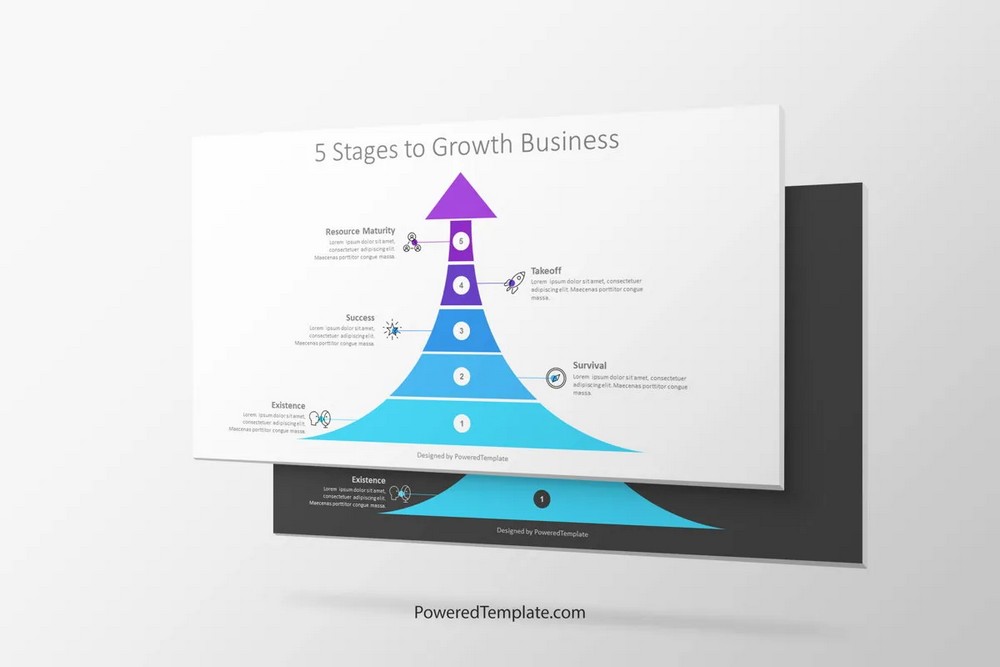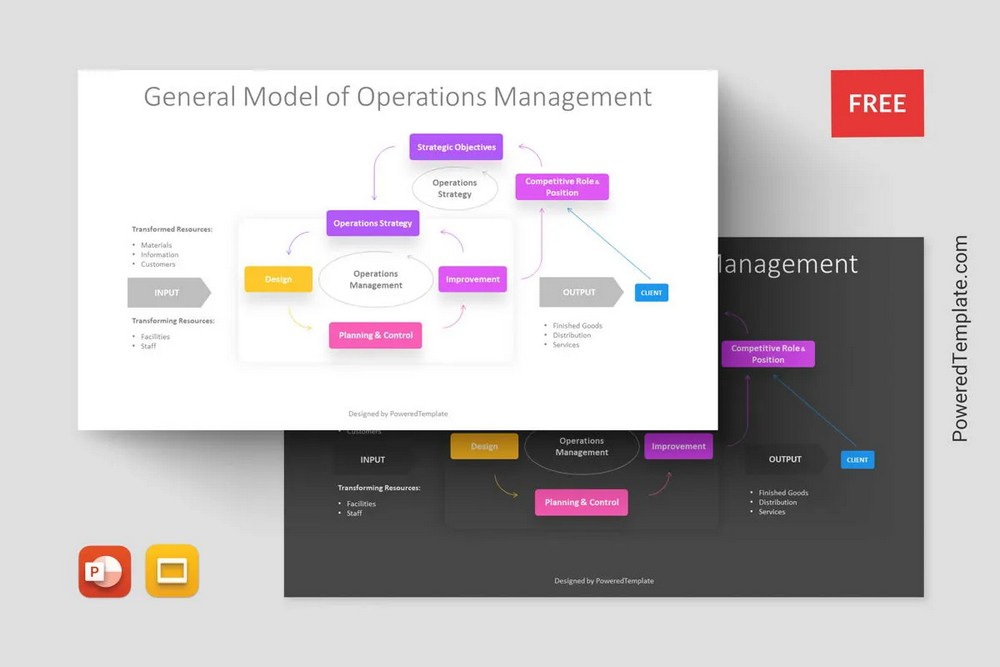This article explores the importance of organizational structure in business management. It delves into the definition and concept of organizational structure, identifies its key components, and examines various types of organizational structures.
The article discusses the factors influencing the organizational structure and provides insights into creating an effective structure. It highlights the benefits of a well-designed organizational structure and emphasizes its significance in business management.
With this text, we continue a series of eight articles dedicated to business management.
This article showcases a range of presentation templates from the PoweredTemplate library that are tailored to the topic of organizational structure in business management. They serve as valuable visual aids for business professionals seeking to elevate their presentations and effectively convey the importance of organizational structure to their teams and stakeholders.
Table of Contents
- Importance of Organizational Structure in Business Management
- Understanding Organizational Structure
- Types of Organizational Structures
- Factors Influencing Organizational Structure
- Creating an Effective Organizational Structure
- Benefits of an Effective Organizational Structure
- Conclusion
Importance of Organizational Structure in Business Management

The organizational structure plays a crucial role in business management and is essential for the success and efficiency of an organization. The well-planned and implemented organizational structure:
- provides a hierarchy, reporting lines, and distribution of tasks within an organization;
- establishes formal communication channels, and smooth flow of information across different levels and departments;
- ensures that tasks and projects move seamlessly through different stages and departments, minimizing bottlenecks and delays;
- allows for the addition of new departments or teams, the creation of new roles, and the redistribution of resources as needed;
- clarifies the decision-making hierarchy and the allocation of authority within the organization;
- provides employees with a sense of direction, purpose, and clarity;
- helps optimize the allocation of resources, including human capital, finances, and equipment.
Overall, a well-planned and implemented organizational structure provides a framework for effective business management, enabling organizations to operate smoothly, adapt to changes, make informed decisions, and achieve their strategic objectives.
Understanding Organizational Structure
In order to comprehend the significance of organizational structure in business management, it is crucial to have a clear understanding of its definition, concept, and key components.
Definition and Concept of Organizational Structure
Organizational structure refers to the framework that outlines
- the hierarchical arrangement of roles, responsibilities, and relationships within a company.
It establishes
- the formal lines of authority, communication channels, and decision-making processes.
The concept of organizational structure is centered around creating a framework that supports
- efficient operations, facilitates coordination, and enables effective management of resources.
Key Components of Organizational Structure

The key components of organizational structure include:
- Hierarchy: This refers to the levels of authority and the chain of command within the organization. It determines the flow of communication and decision-making from top management to lower-level employees.
- Departmentalization: Organizations typically group employees and tasks based on common functions, products, or geographical locations. This division allows for specialization and efficient coordination within departments.
- Span of Control: It pertains to the number of subordinates that a manager can effectively oversee. A wider span of control promotes a flatter organizational structure, while a narrower span of control leads to a more hierarchical structure.
- Centralization and Decentralization: Centralization concentrates decision-making authority at the top, while decentralization delegates decision-making to lower levels of the organization. The degree of centralization or decentralization impacts the flow of information and the autonomy of departments or divisions.
- Formalization: This refers to the extent to which rules, procedures, and policies are established within the organization. Formalization ensures consistency and standardization in processes and behaviors.
Understanding these components provides a solid foundation for comprehending the role and impact of organizational structure in effective business management.
Types of Organizational Structures
Organizations employ various types of organizational structures to align their operations and achieve their goals effectively. Each structure has unique characteristics and implications for business management. Understanding these structures can help organizations make informed decisions about the most suitable approach for their specific needs.
Functional Organizational Structure

The functional organizational structure groups employees based on their specialized functions or areas of expertise. Common functional departments include finance, marketing, operations, and human resources. In this structure, employees report to a functional manager who oversees their work within the respective department. The functional structure is most effective in organizations with a clear division of labor and a stable environment.
Divisional Organizational Structure

The divisional organizational structure groups employees based on specific divisions or units within the organization. Divisions can be formed based on products, services, geographic locations, or customer segments. Each division operates independently and has its own functional departments, such as marketing, finance, and operations. This structure allows for greater focus on division-specific goals and better adaptation to diverse market conditions.
Matrix Organizational Structure

The matrix organizational structure combines elements of both functional and divisional structures. It involves creating cross-functional teams that work on projects or products while also reporting to functional managers. This structure promotes collaboration, as employees from different functions work together, share resources, and contribute their expertise. The matrix structure is beneficial for organizations dealing with complex projects or those requiring high levels of innovation and flexibility.
Network Organizational Structure

The network organizational structure is characterized by a network of independent entities collaborating to achieve common goals. Instead of having a traditional hierarchy, organizations in a network structure form strategic alliances, partnerships, or virtual teams with external entities. This structure enables organizations to leverage external expertise, resources, and capabilities while maintaining agility and adaptability.
Understanding the different types of organizational structures, their characteristics, and implications for business management allows organizations to choose the most suitable approach based on their goals, industry dynamics, and organizational culture. The chosen structure should align with the organization’s strategic objectives, promote effective communication and collaboration, and enable efficient decision-making and resource utilization.
Factors Influencing Organizational Structure
The choice of organizational structure is influenced by various factors that impact business management. Understanding these factors helps organizations design an effective structure that aligns with their goals, maximizes productivity, and promotes success.
Company Size and Stage of Growth

The size of a company and its stage of growth significantly influence its organizational structure. Small startups often adopt a flat structure with minimal hierarchy and flexible roles to promote collaboration and innovation. As companies grow, they may transition to more hierarchical structures to facilitate coordination and control. The size and growth stage of a company impact its ability to adapt to changing market conditions and manage resources efficiently.
Company Culture and Values

Company culture and values play a crucial role in shaping the organizational structure. Organizations with a collaborative and team-oriented culture may opt for flatter structures that empower employees and encourage participation in decision-making. In contrast, organizations with a more traditional or hierarchical culture may adopt structures with clear reporting lines and centralized decision-making. The organizational structure should align with the desired culture and values to foster employee engagement and promote a positive work environment.
Nature of Industry and External Environment
The nature of the industry and the external environment in which a company operates influence its organizational structure:
- dynamic and fast-paced industries, such as technology or fashion, often require flexible and adaptable structures to respond quickly to market changes;
- regulated industries, such as finance or healthcare, may necessitate more hierarchical structures to ensure compliance and manage risks.
The organizational structure should align with industry demands and external market forces to support competitiveness and strategic objectives.
Technology and Information Systems

Technological advancements and information systems have a profound impact on organizational structure. Digital transformation and the adoption of advanced technologies enable remote work, collaboration, and real-time information sharing, making flatter and more decentralized structures viable options. Organizations leveraging digital platforms and data-driven decision-making may require structures that facilitate cross-functional collaboration and knowledge exchange. The organizational structure should leverage technology to enhance efficiency, communication, and knowledge management.
By considering factors such as company size, growth stage, culture, industry dynamics, external environment, and technological advancements, organizations can design an organizational structure that supports effective business management. A well-aligned structure promotes clear communication, efficient coordination, and the optimal use of resources, enabling organizations to navigate challenges, drive growth, and achieve their strategic goals.
Creating an Effective Organizational Structure
Designing and implementing an effective organizational structure is crucial for successful business management. This section explores the key steps involved in creating a structure that aligns with the organization’s goals, enhances efficiency, and supports growth.
Assessing Organizational Needs and Goals

Before designing the structure, it is essential to assess the organization’s needs and goals. This involves understanding the strategic objectives, operational requirements, and desired outcomes. By evaluating the organization’s vision, mission, and core values, leaders can identify the key factors that should be reflected in the structure. This assessment ensures that the organizational structure is aligned with the overall direction and supports the achievement of business management objectives.
Determining the Appropriate Structure Based on Factors Discussed
Based on the assessment of organizational needs and goals, leaders can determine the most suitable organizational structure. Considering factors such as
- the nature of work, size of the organization, desired level of flexibility, and communication requirements,
they can select from different types of structures, such as
- functional, divisional, matrix, or network structures.
It is important to choose a structure that optimally balances the organization’s unique requirements and promotes effective business management.
Considerations for Implementing and Managing the Structure
Implementing the chosen organizational structure requires careful planning and consideration. Leaders need to define roles and responsibilities, establish reporting lines, and ensure clear communication channels. They should also address any potential challenges or resistance to change that may arise during the implementation process. Ongoing management of the structure involves monitoring its effectiveness, addressing issues, and making adjustments as needed. Effective change management practices and regular evaluation are essential for successful implementation and management of the organizational structure.
Monitoring and Adapting the Structure Over Time
An organizational structure is not a static entity and should be regularly monitored and adapted as needed. As the business environment evolves, new challenges and opportunities may arise, requiring adjustments to the structure. Continuous evaluation and feedback from employees and stakeholders help identify areas for improvement and ensure the structure remains aligned with business management needs. By monitoring and adapting the structure over time, organizations can maintain agility, optimize performance, and support long-term success.
Creating an effective organizational structure involves assessing organizational needs, determining the appropriate structure, carefully implementing and managing it, and monitoring and adapting it over time. By following these steps, organizations can establish a structure that promotes effective business management, fosters collaboration, and drives organizational growth and success.
Benefits of an Effective Organizational Structure
An effective organizational structure in business management brings numerous advantages that contribute to overall success and productivity. This section explores the key benefits of having a well-designed structure.
Enhanced Communication and Collaboration
A well-defined organizational structure facilitates clear communication channels and promotes effective collaboration among team members. By having defined reporting lines and communication protocols, employees can share information, ideas, and feedback more efficiently. This fosters better coordination, minimizes misunderstandings, and encourages synergy across departments or teams, leading to improved overall performance.
Increased Efficiency and Productivity
An optimal organizational structure ensures that roles and responsibilities are clearly defined and aligned with the organization’s objectives. This clarity eliminates duplication of efforts and minimizes confusion about who is accountable for specific tasks. With efficient workflow processes and streamlined decision-making, employees can focus on their core responsibilities, leading to increased productivity and operational efficiency.
Clearer Roles and Responsibilities
A well-designed organizational structure provides employees with a clear understanding of their roles and responsibilities within the organization. This clarity helps individuals to know their areas of authority, decision-making power, and expectations. When employees have a clear understanding of their roles, they can work more effectively, make informed decisions, and contribute to the overall success of the organization.
Improved Decision-making and Problem-solving
A structured organizational setup ensures that decision-making processes are defined and consistent across the organization. With clear hierarchies and designated decision-makers, organizations can make decisions more efficiently and effectively. This structure also enables timely problem-solving, as issues can be escalated to the appropriate levels of authority. Effective decision-making and problem-solving contribute to better outcomes and enhance the organization’s ability to adapt to changing circumstances.
Better Employee Morale and Engagement
A well-functioning organizational structure promotes a positive work environment and enhances employee morale and engagement. When employees understand their roles and have opportunities for growth and development within the structure, they are more likely to feel valued and motivated. Clear career paths and performance expectations contribute to higher job satisfaction and foster a sense of belonging and commitment among employees.
By establishing an effective organizational structure, businesses can experience enhanced communication and collaboration, increased efficiency and productivity, clearer roles and responsibilities, improved decision-making and problem-solving, and better employee morale and engagement. These benefits create a strong foundation for successful business management and contribute to the organization’s overall growth and prosperity.
Conclusion
The importance of organizational structure in business management cannot be overstated. An effective structure serves as the foundation for successful operations, fostering collaboration, efficiency, and growth. Throughout this article, we have explored the definition, types, factors influencing, and creation of an organizational structure. We have seen how different structures, such as functional, divisional, matrix, and network structures, impact business management in unique ways.
By carefully assessing organizational needs and goals, determining the appropriate structure, and implementing it thoughtfully, organizations can unlock numerous benefits. These include enhanced communication and collaboration, increased efficiency and productivity, clearer roles and responsibilities, improved decision-making and problem-solving, and better employee morale and engagement.
However, it’s important to remember that an organizational structure is not a one-size-fits-all solution. It should be regularly monitored, evaluated, and adapted as needed to align with changing business needs and external factors. Organizations must be agile and responsive, willing to make adjustments to optimize their structure for continued success.
In conclusion, a well-designed and well-managed organizational structure is a critical component of effective business management. It lays the groundwork for smooth operations, efficient workflows, and productive teams. By emphasizing the importance of organizational structure and encouraging ongoing exploration and implementation of effective structures, businesses can position themselves for sustained growth and competitive advantage in today’s dynamic and evolving business landscape.




